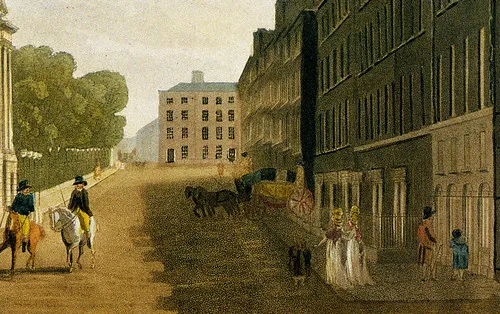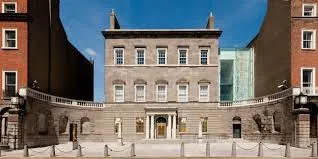Parnell Square and its Buildings
Parnell Square is the earliest, and regarded by many as the finest, of Dublin’s Georgian Squares. Its significance in Dublin’s history predates the Georgian period. Previous excavations have uncovered burials believed to be from the battle of Clontarf in 1014.
In 1757, Dr. Bartholomew Mosse built Britain and Ireland’s first public maternity hospital on Parnell Square. It was financed through money raised from the wealthy patrons of his adjoining “pleasure gardens” developed earlier in 1750. The square evolved from the gardens of the Lying-In Hospital. The building of the square was completed in 1785. It is the only Georgian square featured in James Malton’s “Views of Dublin”. Originally named Rutland Square, its name was subsequently changed to the present, named for the political leader, Charles Stewart Parnell.
Parnell Square consists of terraces of substantial houses built around a central garden, with the Rotunda Hospital at its core. The grand scale of the buildings allowed them to be adapted during the nineteenth century for hotels, offices or institutional uses. The north side of the square, with Charlemont House, at its centrepiece, is uniquely the closest to a designed “palace” front in Dublin. It was originally called Palace Row.
The City Library will be accommodated on the site and to the rear of the former Coláiste Mhuire to the left of Dublin City Gallery Hugh Lane. The north side of Parnell Square has a designed terrace elevation with Charlemont House at its centre.

Charlemont House
Charlemont House was designed by William Chambers for Lord Charlemont and was built in 1765. The design provided a majestic centrepiece for a unique streetscape, unrivalled amongst Irish Georgian squares. It is considered to have the most impressive setting of any Georgian townhouse in Dublin. The views, particularly from the upper floors of the houses, are unrivalled in Dublin – looking south from an elevated site towards the Dublin Mountains and Dublin Bay.
The main house is one of the finest examples of 18th century Dublin architecture with fine plasterwork and fireplaces (including one by renowned Italian craftsman, Pietro Bossi). In 1933, Charlemont House opened as the permanent location of the Municipal Gallery of Modern Art, now Dublin City Gallery The Hugh Lane.

Coláiste Mhuire Houses, Nos. 23 to 28
The six Georgian buildings that are included in the project, nos. 23 to 28, are protected structures and have impressive interiors. These historic Georgian buildings are an irreplaceable part of Dublin’s architectural and cultural heritage. The houses were acquired by the Christian Brothers over a number of years to provide second level education through the medium of Irish. The six buildings provided an interconnected complex for the school until it closed in 2002.
No. 23
No. 23 was home to barristers through much of the 19th century. By the end of that century however, it had become the home of the Congested Districts Board of Ireland, and was connected to No. 24. Prior to its acquisition by the Christian Brothers, it was used by the Inland Revenue in the 1920s.
No. 24
No. 24 was interlinked to No. 23 and used by the Congested Districts Board from 1900, and later by the Inland Revenue.
No. 25
Built by carpenter, Thomas McDermott, the earliest lease dates from 1764. However, it is the 20th century which is the most significant in the history of this house. In 1901, the Calaroga Club was based here. This was a literary and social centre for Catholic laymen engaged in professional or commercial pursuits. They raised money for the erection of a new south aisle at St. Saviour’s Dominican Church through the Calaroga Grand Bazaar and Fete in the Rotunda.
The Gaelic League was based in this house from 1909. The League was founded to revive and restore the use of the national language. It was here that the Supreme Council of the Irish Republican Brotherhood, presided over by Thomas J. Clarke, met on 9 September 1914, and resolved to bring about a rising against British Rule in Ireland before the end of the war.
No. 26
Also built by Thomas McDermott. For many years during the 1800s it was home to successive members of the legal profession. It changed use in 1895 to the “Young Women’s Christian Association Institution and Home”. The Census of 1901 lists twenty three young women, aged 15 to 29, boarding at this address from counties all over Ireland, as well as Chicago ad Bermuda. The Congested Districts Board took over the building in 1913; the Inspector of Taxes in 1924, before it was acquired by the Christian Brothers in 1934.
No. 27
In the late 19th century, the house was occupied by Arthur Dudgeon, civil engineer and architect. He designed the Ryevale Distillery at Leixlip, Co. Kildare (erected 1875). He also created drawings for the proposed Lyceum Theatre at Pearse Street and Tara Street, but the project did not go ahead. He was architect to the “Association for the housing of the very poor”. The house was acquired, along with no. 26, for the Congested Districts Board, and later by the Inspector of Taxes. The Coláiste Mhuire theatre, an Amharclann, was built to the rear of the school in the 1960s, with access provided via no. 27.
No. 28
The most remarkable of the houses built as Palace Row. The façade to Parnell Square is a side elevation, with the octagonal entrance hall on Granby Row. The house functioned as a school for ladies from 1856 to 1938, under different titles. Usage changed in the late 1930s to offices for importers, manufacturers and wholesalers, before it was taken over by the department of Posts and Telegraphs in the mid-1950s. The house was incorporated into Coláiste Mhuire in 1971, the final house in the row to form the school complex.